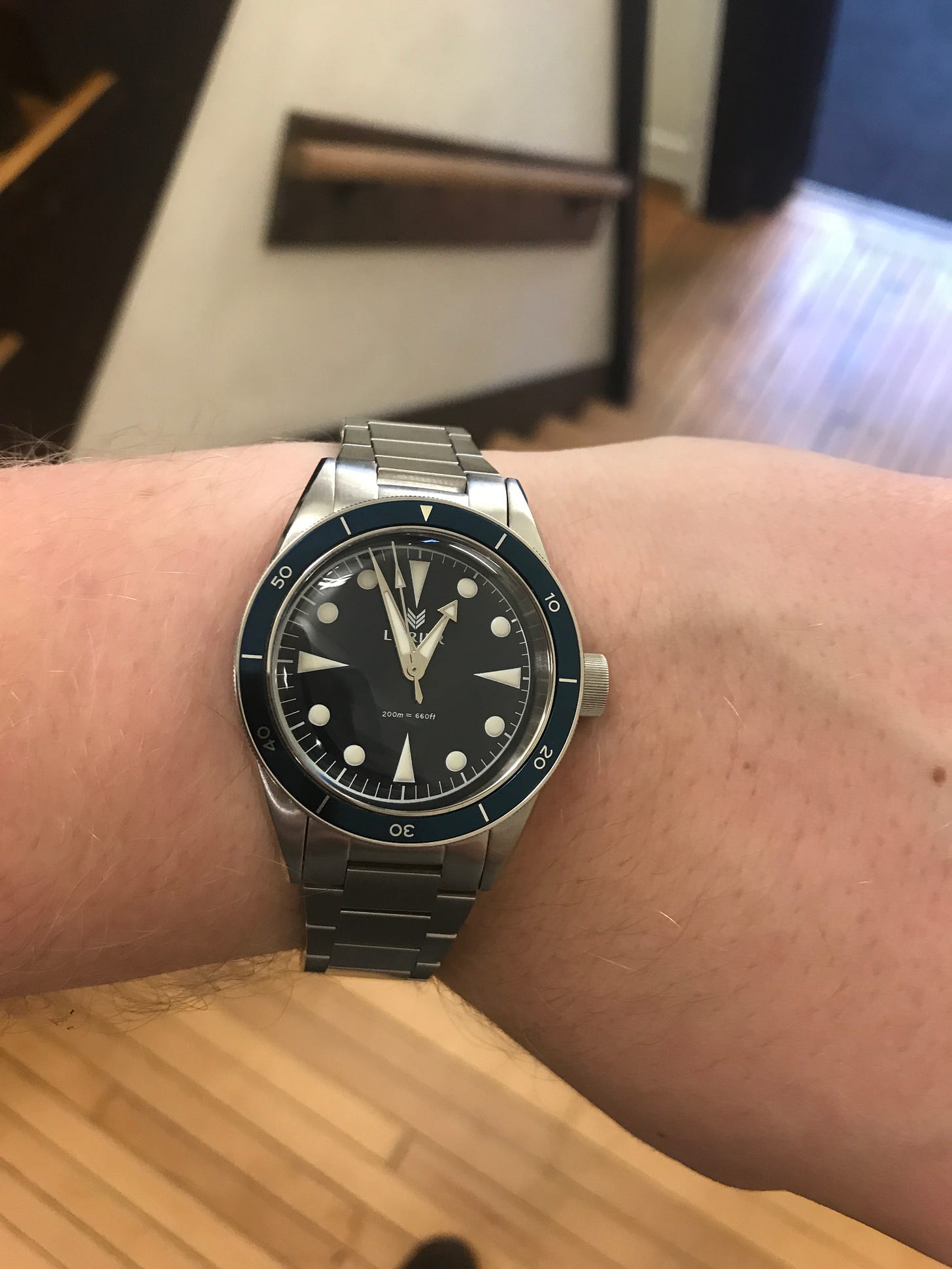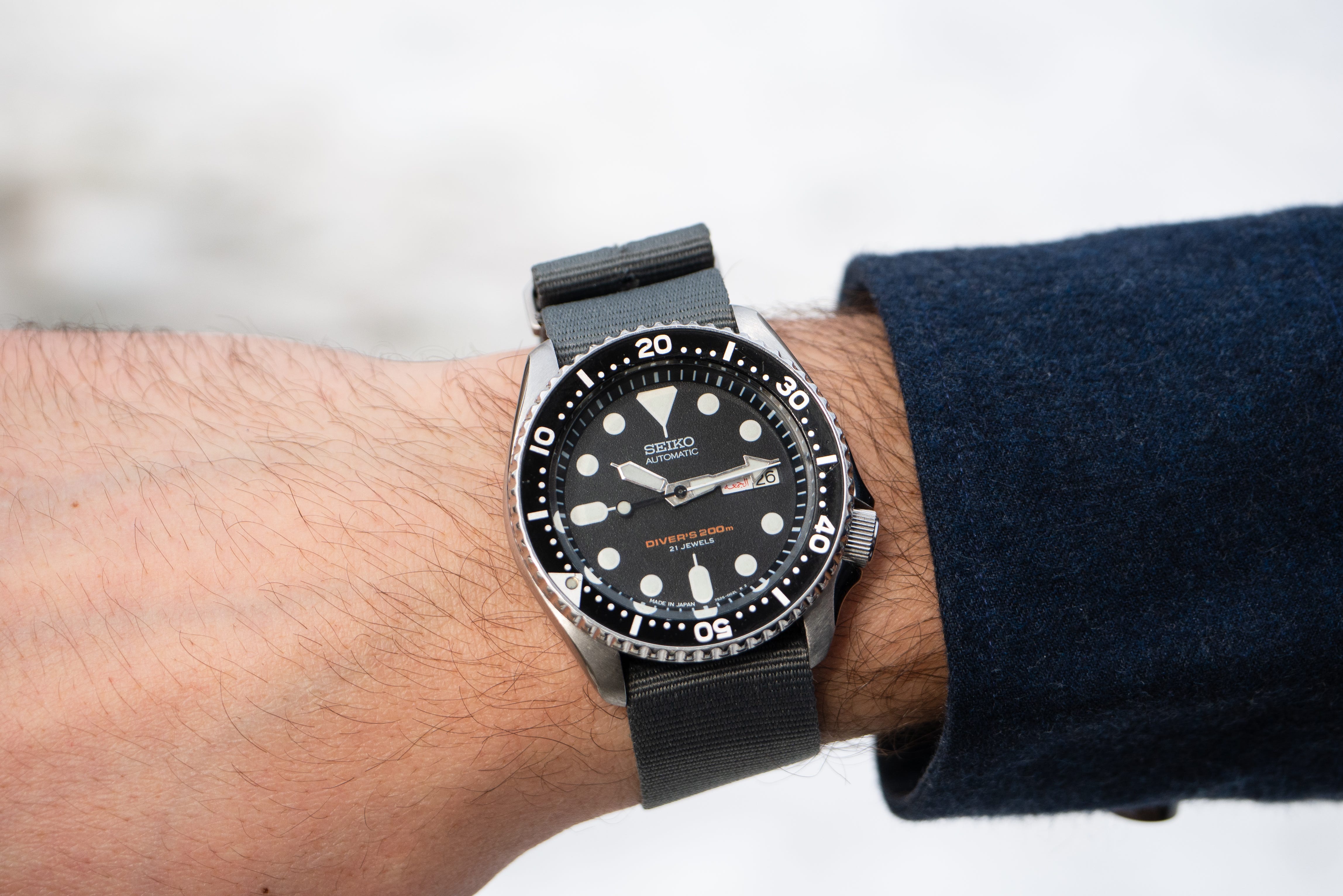When I bought my first Seiko SKX over a decade ago, I paid 75 dollars for it. It worked for about a month, and by the time it stopped ticking, I had already kind of lost interest in it. I don’t know where that watch is, but I have a feeling I probably lost it into the ether of some long forgotten junk drawer.
I probably should have spent a little bit more and gotten a slightly better example, but I was young and stupid and, in hindsight, I probably would never have been satisfied by that watch at that time. I wanted that watch as a placeholder for watches I couldn’t yet afford. Again — young and stupid.
Eventually I found my way back to the SKX. When I was in college, the SKX seemed to drift in and out of my life, but they never really found a permanent place in my watch roll. They were affordable enough that I could give them away or sell them at a loss without too much worry, which tended to happen, because I just couldn’t bring myself to fall head over heels or the iconic dive watch.

Eventually, I did find a dive watch that stuck — a Lorier Neptune V.2 — and it completely changed both how I wear watches and how I approached affordable watches. I had always seen microbrands and other affordable watches as a bit of a compromise, and not one that I was particularly willing to make. That Lorier opened me up to judging watches more on the promise of their own premises, rather than comparing them to watches from wildly different worlds.
This change in perspective brought me back to Seiko in a real way, although I never really went after the SKX again. Why would I? I had owned the SKX, dismissed it and, besides, there was a whole world of Seiko available to me — I wanted to explore. I modded a Seiko 5, experimented with Prospex, and even briefly dipped my toe into a massive solar dive chronograph. For the most part, my liaisons with Seiko have been brief but impactful.
Today, I don’t have a ton of Seikos floating around — part of a commitment on my part to really pare down the scale of my collection in the last few months and sort of start again with a fresh slate — but recently I have started to feel the pull of the SKX again. There’s just one problem, the Seiko SKX is not necessarily a particularly cheap watch anymore.
Wildly, I’ve seen SKXs listed for 6,7, or even 800 dollars in the last year. Thankfully, prices for the model have dropped again, and you can now find an example in good working condition for around 300 bucks (maybe a bit more for the Pepsi-bezeled SKX009), but that’s still a far cry from the days when a decent SKX could be had for under $150.
So, what do you get for that money? Well, for one thing, you get one of the most iconic dive watches of all time. In some ways, what you get is the ur-dive watch. I would hazard to guess that more Seiko dive watches have found themselves on the wrists of divers than either the Rolex Submariner or the Blancpain Fifty Fathoms, and while the SKX007 doesn’t match the most up to date set of ISO specs for dive watches, the DNA of this watch is 100% pure unadulterated dive watch.
To put it more practically, what you get is a 42mm steel dive watch with a black dial, black bezel (on the SKX007), tons of lume, day, date, 120-click unidirectional rotating bezel, 200m of water resistance, and an automatic movement — frequently all on a bracelet. With all that, it’s hard to imagine a better value (and capacity) for money option than the SKX, so why isn’t this the only watch any of us wear?
Well, for as much as you get with the SKX, you also have to give up a fair amount. At the end of the day, the SKX is fundamentally a budget watch, and the corners Seiko has to cut to get there are somewhat apparent, especially if you’ve spent any time with equivalent watches even slightly more expensive. The movement of the SKX neither hacks nor hand winds, and its not particularly accurate. I mean, at the end of the day, even keeping time to within a minute a day is an extraordinary feat of engineering, but the wandering timekeeping of the SKX’s 7S26 is noticeable — even if you’re not looking for it.
I would also say the stated promise of a 40-ish hour power reserve is rarely matched in practice, and I tend to find the model I’ve been wearing for the last two weeks or so tends to wind down about 18 hours after I take off the watch. At least on my wrist, watches with shake-and-bake Seiko movements rarely seem to manage a full wind, but I allow for that being my fault.
As I said, I’ve been borrowing the SKX007 from a friend, and I’ve been wearing it both on and off the Jubilee-clone bracelet. As for the bracelet itself, I think we all know what to expect at this point — it’s a little rattly, a bit jangly, and the end links pull at my arm hair just enough to notice. Besides that, the bracelet is remarkably comfortable. Shudder to say it, but at first blush, it doesn’t even feel that far off the Jubilee bracelet of my 1978 Datejust.
When you dig a little deeper, the differences become more obvious, although for the most part I don’t mind the changes. The links on the Seiko bracelet are folded, which I like — the Jubilee bracelet as a concept plays up a dressy, high-end ideal; that you can see the manufacturing that goes into the SKX bracelet betrays the watches toolish roots. The clasp doesn’t really match the draping style of the bracelet, but it’s robust and reliable, so again, no complaints.
Where I do start to complain is in sizing the bracelet. The folded links of the SKX bracelet are held together by flat pins held in place by a small bubble and two folded over tangs. It works well enough, and compared to the pin and collar system used on many Seiko bracelets, is relatively easy to re-size yourself, but there is certainly a ceiling on how many times that resizing will work reliably.
My guess is Seiko felt this wouldn’t be a problem. For the most part, it probably isn’t — unless a watch starts getting passed around over and over in an enthusiast group by people with different size wrists, but I digress, since I mostly (exclusively) wear the SKX on a NATO.
Which I suppose brings us to the question of how the watch wears, but first a caveat. I have a large wrist. With that in mind, I have absolutely no issues wearing the 42.5mm SKX. With its short lug-to-lug, tall bezel, and rounded sided, the SKX does look like it would be a little bulbous. Mike, who I borrowed it from had issues with the thickness, as did my friend Quinn (on whose wrist the watch is modeled in several shots), but I had no issue with it whatsoever.
In fact, despite being 2.5mm larger in diameter, it actually feels dramatically smaller on my wrist than the Vertex M60 Aqualion ND I wear most days. It’s even thinner (by less than half a millimeter, but still…)! The SKX certainly doesn’t vanish on your wrist, but by no means is it a monster either. It feels like what it is; solid.
And I don’t think I would want the SKX to be any smaller or thinner. It so is what it is, and that is exactly what has made it so special. To borrow a turn of phrase, it is precisely one unit of steel sports watch, ready for whatever you ask of it.
That doesn’t mean that I don’t have some complaints. For one thing, I just don’t like having the day of the week on my watch. I put up with it, I accept it, but I’d rather do without. Especially here, where I would much rather have another lume plot than either the day or the date. I know that it is a Seiko hallmark, and the bi-language date wheel can be a fun party trick, but I just have no need or love for it.
As for the 4 o’clock crown, I am indifferent to its presence. I didn’t like it when I first got the watch, but I genuinely don’t mind it now. It is such a big part of the watches identity that I would be hard pressed to imagine it without. I’ve even frown to love the asymmetric look it offers. But the crown guards are a problem. They are certainly effective, but they extend too far towards the caseback. This isn’t something I notice when wearing the watch, but it really hurts the tactile experience of setting the watch. If it were my watch, I’d be inclined to take a polishing wheel to the underside of the guards and knock the corner off.
So, what do I really think of the Seiko SKX? Well, it all depends on what you pay for it. At $75, the Seiko SKX007 is possibly the best watch ever made; at $150, there has likely never been a better watch for the money; at $300, we’re talking about an icon, you can justify it (barely). If you pay any more than that, you’ve made a mistake.
The watch space under $1000 has exploded in the last two decades. The Seiko SKX is a beast of a thing. It is the starting off point for more collectors than just about any other individual watch model, and it’s a watch that begs curiosity and interest. It’s a great watch, for the money. But don’t spend $600 on one. Don’t even spend $400. But if you do have an SKX, wear the ever-living hell out of it — you’ll be glad you did.








